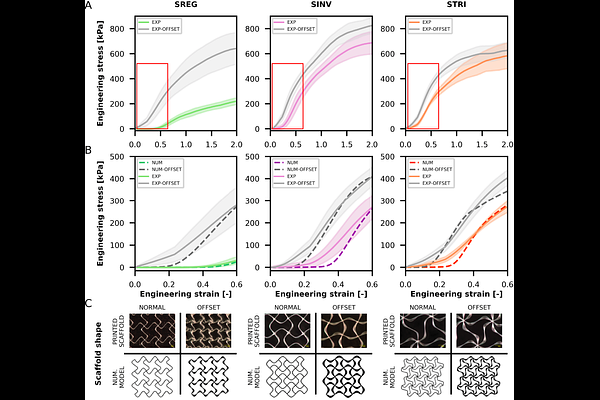Rational Design and Modeling of Auxetic Fiber Scaffolds for Soft Tissue Engineering via Melt Electrowriting

Rational Design and Modeling of Auxetic Fiber Scaffolds for Soft Tissue Engineering via Melt Electrowriting
Lecina-Tejero, O.; Iamsamang, J.; Alaman-Diez, P.; Garcia-Gareta, E.; Cuartero, J.; Perez, M. A.; Castilho, M.; Borau, C.
AbstractBackground: The development of regenerative biomaterial scaffolds with mechanical properties tailored to native soft tissues remains a challenge in tissue engineering. Mechanical metamaterials with auxetic architectures have taken enormous flight over the past years, as they offer improved control over mechanical function and performance through spatially defined material architecture. However, despite their potential, auxetic scaffold designs are often developed empirically, and the relationship between scaffold microarchitecture, mechanical function, and manufacturability remains poorly defined, limiting their applicability in tissue engineering. In this study, we present a computational framework for the rational design of auxetic fiber scaffolds manufactured using Melt Electro-writing (MEW) for soft tissue engineering. To address the challenge of tailoring scaffold mechanical properties to native tissue, we integrated finite element method (FEM) modeling with experimental validation to predict the mechanical behavior of the scaffolds. Method: The micro-fibrous scaffolds with customizable auxetic re-entrant structures were designed using Python scripts for generating G-code used in fabrication and for model definition in FEM modeling, respectively. Four distinct auxetic structures were selected for this study to cover the wide range of mechanical properties of soft tissue, and their geometry parameters were adjusted to reduce the pore size while considering printing resolution. FEM modeling was employed to predict the mechanical behavior of the scaffolds. To validate the predictions, the scaffolds were manufactured via MEW and characterized mechanically under biaxial tensile loading. Results and conclusion: MEW manufacturing enabled the production of auxetic fiber scaffolds with sub-millimeter pore resolution, while rational design allowed to correct fabrication discrepancies and improve printed design fidelity. Experimental biaxial characterization of the scaffolds revealed design-dependent, biphasic, non-linear mechanical response, and the developed FEM model was capable of not only accurately simulating the observed mechanical response but also accounting for variations introduced by MEW during fabrication. Additionally, auxetic scaffolds supported fibroblast viability over 7 days, confirming biocompatibility as a first step toward soft tissue engineering. The good alignment between numerical predictions and experimental results highlights the value of FEM modeling as a powerful computational tool for guiding the design and optimization of auxetic scaffolds with tailored mechanical performance for specific soft tissue requirements. The presented methodology offers a significant advancement in the development of functional biomaterials for biomedical applications.